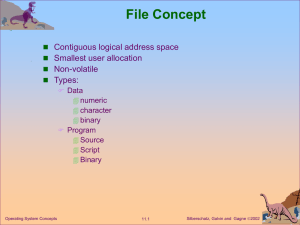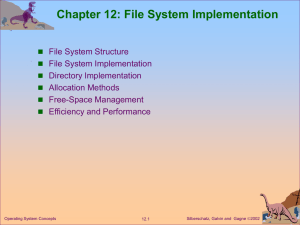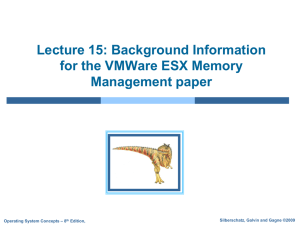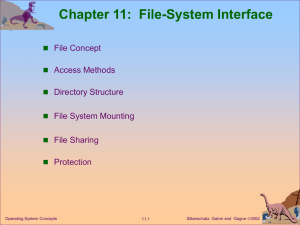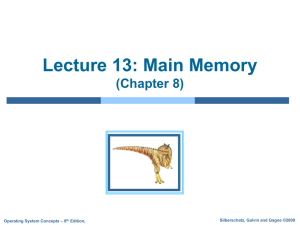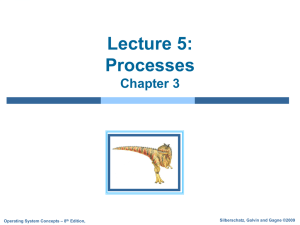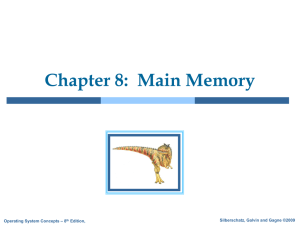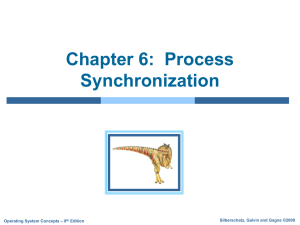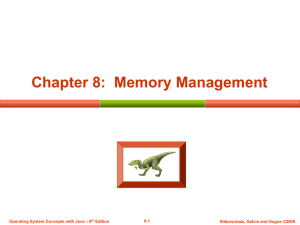File-System Interface
advertisement
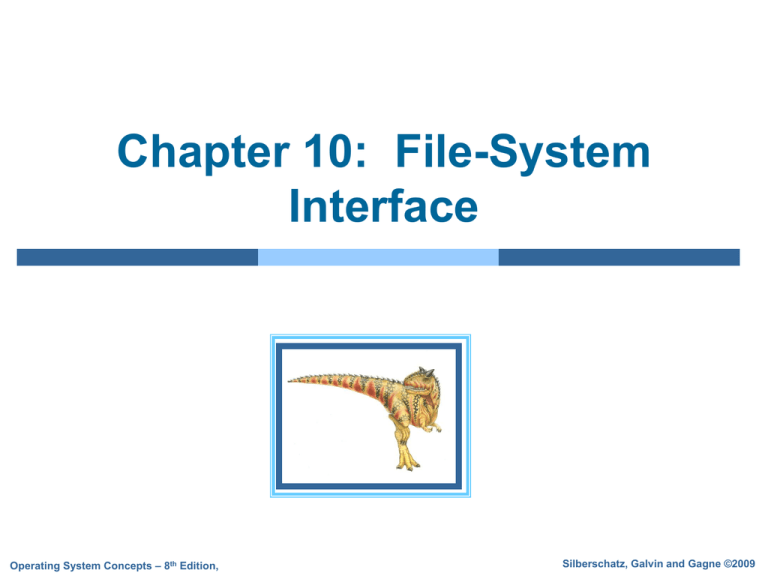
Chapter 10: File-System Interface Operating System Concepts – 8th Edition, Silberschatz, Galvin and Gagne ©2009 Chapter 10: File-System Interface File Concept Access Methods Directory Structure Operating System Concepts – 8th Edition 10.2 Silberschatz, Galvin and Gagne ©2009 Objectives To explain the function of file systems To describe the interfaces to file systems To discuss file-system design tradeoffs, including access methods, file sharing, file locking, and directory structures Operating System Concepts – 8th Edition 10.3 Silberschatz, Galvin and Gagne ©2009 File Concept Contiguous logical address space Types: Data numeric character binary Program Operating System Concepts – 8th Edition 10.4 Silberschatz, Galvin and Gagne ©2009 File Structure None - sequence of words, bytes Simple record structure Lines Fixed length Variable length Complex Structures Formatted document Relocatable load file Can simulate last two with first method by inserting appropriate control characters Who decides: Operating system Program Operating System Concepts – 8th Edition 10.5 Silberschatz, Galvin and Gagne ©2009 File Attributes Name – only information kept in human-readable form Identifier – unique tag (number) identifies file within file system Type – needed for systems that support different types Location – pointer to file location on device Size – current file size Protection – controls who can do reading, writing, executing Time, date, and user identification – data for protection, security, and usage monitoring Information about files are kept in the directory structure, which is maintained on the disk Operating System Concepts – 8th Edition 10.6 Silberschatz, Galvin and Gagne ©2009 Example of File Attributes UNIX: ls -li 26047823 -rw-r--r-- 1 Salim staff 596480 Mar 16 20:17 Lecture10.ppt Operating System Concepts – 8th Edition 10.7 Silberschatz, Galvin and Gagne ©2009 File Operations File is an abstract data type Create Write Read Reposition within file Delete Truncate Open(Fi) – search the directory structure on disk for entry Fi, and move the content of entry to memory Close (Fi) – move the content of entry Fi in memory to directory structure on disk Operating System Concepts – 8th Edition 10.8 Silberschatz, Galvin and Gagne ©2009 Open Files Several pieces of data are needed to manage open files: File pointer: pointer to last read/write location, per process that has the file open File-open count: counter of number of times a file is open – to allow removal of data from open-file table when last processes closes it Disk location of the file: cache of data access information Access rights: per-process access mode information Operating System Concepts – 8th Edition 10.9 Silberschatz, Galvin and Gagne ©2009 File Types – Name, Extension Operating System Concepts – 8th Edition 10.10 Silberschatz, Galvin and Gagne ©2009 Access Methods Sequential Access read next write next reset no read after last write (rewrite) Direct Access read n write n position to n read next write next rewrite n n = relative block number Operating System Concepts – 8th Edition 10.11 Silberschatz, Galvin and Gagne ©2009 Sequential-access File Operating System Concepts – 8th Edition 10.12 Silberschatz, Galvin and Gagne ©2009 Simulation of Sequential Access on Direct-access File Operating System Concepts – 8th Edition 10.13 Silberschatz, Galvin and Gagne ©2009 Example of Index and Relative Files Operating System Concepts – 8th Edition 10.14 Silberschatz, Galvin and Gagne ©2009 Directory Structure A collection of nodes containing information about all files Directory Files F1 F2 F3 F4 Fn Both the directory structure and the files reside on disk Backups of these two structures are kept on tapes Operating System Concepts – 8th Edition 10.15 Silberschatz, Galvin and Gagne ©2009 A Typical File-system Organization Operating System Concepts – 8th Edition 10.16 Silberschatz, Galvin and Gagne ©2009 Operations Performed on Directory Search for a file Create a file Delete a file List a directory Rename a file Traverse the file system Operating System Concepts – 8th Edition 10.17 Silberschatz, Galvin and Gagne ©2009 Organize the Directory (Logically) to Obtain Efficiency – locating a file quickly Naming – convenient to users Two users can have same name for different files The same file can have several different names Grouping – logical grouping of files by properties, (e.g., all Java programs, all games, …) Operating System Concepts – 8th Edition 10.18 Silberschatz, Galvin and Gagne ©2009 Single-Level Directory A single directory for all users Naming problem Grouping problem Operating System Concepts – 8th Edition 10.19 Silberschatz, Galvin and Gagne ©2009 Two-Level Directory Separate directory for each user Path name Can have the same file name for different user Efficient searching No grouping capability Operating System Concepts – 8th Edition 10.20 Silberschatz, Galvin and Gagne ©2009 Tree-Structured Directories Operating System Concepts – 8th Edition 10.21 Silberschatz, Galvin and Gagne ©2009 Tree-Structured Directories (Cont) Efficient searching Grouping Capability Current directory (working directory) cd /spell/mail/prog type list Operating System Concepts – 8th Edition 10.22 Silberschatz, Galvin and Gagne ©2009 Tree-Structured Directories (Cont) Absolute or relative path name Creating a new file is done in current directory Delete a file rm <file-name> Creating a new subdirectory is done in current directory mkdir <dir-name> Example: if in current directory /mail mkdir count mail prog copy prt exp count Deleting “mail” deleting the entire subtree rooted by “mail” Operating System Concepts – 8th Edition 10.23 Silberschatz, Galvin and Gagne ©2009 Acyclic-Graph Directories Have shared subdirectories and files Operating System Concepts – 8th Edition 10.24 Silberschatz, Galvin and Gagne ©2009 Acyclic-Graph Directories (Cont.) Two different names (aliasing) If dict deletes list dangling pointer Solutions: Backpointers, so we can delete all pointers Variable size records a problem Backpointers using a daisy chain organization Entry-hold-count solution New directory entry type Link – another name (pointer) to an existing file Resolve the link – follow pointer to locate the file Operating System Concepts – 8th Edition 10.25 Silberschatz, Galvin and Gagne ©2009 General Graph Directory Operating System Concepts – 8th Edition 10.26 Silberschatz, Galvin and Gagne ©2009 General Graph Directory (Cont.) How do we guarantee no cycles? Allow only links to file not subdirectories Garbage collection Every time a new link is added use a cycle detection algorithm to determine whether it is OK Operating System Concepts – 8th Edition 10.27 Silberschatz, Galvin and Gagne ©2009 End of Chapter 10 Operating System Concepts – 8th Edition, Silberschatz, Galvin and Gagne ©2009
